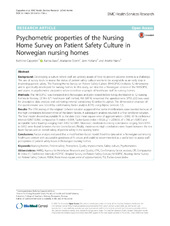| dc.contributor.author | Cappelen, Kathrine | |
| dc.contributor.author | Aase, Karina | |
| dc.contributor.author | Storm, Marianne | |
| dc.contributor.author | Hetland, Jørn | |
| dc.contributor.author | Harris, Anette | |
| dc.date.accessioned | 2016-11-30T11:59:41Z | |
| dc.date.available | 2016-11-30T11:59:41Z | |
| dc.date.issued | 2016-08-27 | |
| dc.Published | BMC Health Services Research 2016, 16(1):446 | eng |
| dc.identifier.issn | 1472-6963 | |
| dc.identifier.uri | https://hdl.handle.net/1956/13159 | |
| dc.description.abstract | Background: Developing a culture where staff are actively aware of how to prevent adverse events is a challenge. The use of survey tools to assess the status of patient safety culture seems to be acceptable as an early step in improving patient safety. The Nursing Home Survey on Patient Safety Culture (NHSOPSC) includes 12 dimensions and is specifically developed for nursing homes. In this study, we describe a Norwegian version of the NHSOPSC and assess its psychometric properties when tested on a sample of healthcare staff in nursing homes. Methods: The NHSOPSC was translated into Norwegian and pilot tested before being distributed to 12 nursing homes in Norway. Of the 671 healthcare staff invited, 466 (69 %) answered the questionnaire. SPSS 23.0 was used for descriptive data analysis and estimating internal consistency (Cronbach’s alpha). The dimensional structure of the questionnaire was tested by confirmatory factor analysis (CFA) using Mplus (version 7.2). Results: The CFA testing of the original 12-factor solution suggested that some modifications were needed because of the high correlations between three of the latent factors. A subsequent analysis resulted in a final ten-factor solution. The final model showed acceptable fit to the data (root mean square error of approximation = 0.060, 90 % confidence interval: 0.057–0.063, comparative fit index = 0.934, Tucker-Lewis index = 0.926, χ2 = 2058.33, df = 765, p < 0.001) and acceptable factor loadings ranging from 0.402 to 0.891. Moreover, moderate-to-strong correlations ranging from 0.455 to 0.812 were found between the ten latent factors. Finally, moderate-to-high correlations were found between the ten latent factors and an overall rating of patient safety in the nursing home. Conclusions: Factor analysis indicated that a modified ten-factor model fitted the data set in a Norwegian community healthcare context with acceptable goodness-of-fit values and could be recommended as a useful tool to assess staff perceptions of patient safety issues in Norwegian nursing homes. | en_US |
| dc.language | en | |
| dc.language.iso | eng | eng |
| dc.publisher | BioMed Central | eng |
| dc.rights | Attribution CC BY | eng |
| dc.rights.uri | http://creativecommons.org/licenses/by/4.0 | eng |
| dc.subject | Nursing homes | eng |
| dc.subject | Patient safety | eng |
| dc.subject | Perception | eng |
| dc.subject | Quality improvement | eng |
| dc.subject | Safety culture | eng |
| dc.subject | Psychometrics | eng |
| dc.title | Psychometric properties of the Nursing Home Survey on Patient Safety Culture in Norwegian nursing homes | eng |
| dc.type | Peer reviewed | |
| dc.type | Journal article | |
| dc.date.updated | 2016-10-11T12:03:05Z | |
| dc.description.version | publishedVersion | |
| dc.rights.holder | Copyright 2016 The Author(s) | eng |
| dc.identifier.doi | https://doi.org/10.1186/s12913-016-1706-x | |
| dc.identifier.cristin | 1376548 | |

